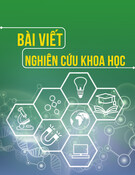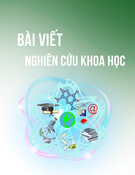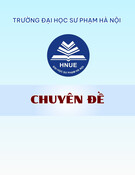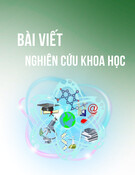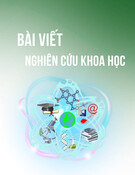
KHOA HỌC, GIÁO DỤC VÀ CÔNG NGHỆ
74 April, 2025
MOTIVATIONAL FACTORS INFLUENCING KHMER
VIETNAMESE EFL TEACHERS’ CAREER CHOICE
Vo Van Sia
Ngo Huynh Hong Ngab
Drawing on Self-Determination theory, the current study examined how intrinsic, altruistic and
extrinsic factors affected their career choice within the sociocultural context of the Khmer ethnic
community. Extrinsic motivations such as job stability and social respect were found to be secondary
motivational factors. These findings provide an insightful understanding of what motivated teachers in
ethnically diverse contexts to choose teaching career and highlight the importance of integrating cultural
and social considerations into teacher recruitment and retention strategies.
Keywords: English teaching career choice; Motivation; Mekong Delta; Khmer ethnic minority group;
Vietnam.
aCan Tho University; Tay Do University; Email: vvsi@tdu.edu.vn
bCan Tho University; Email: nhhnga@ctu.edu.vn
Received: 10/01/2025; Reviewed: 21/01/2025; Revised: 10/02/2025; Accepted: 25/3/2025; Released: 28/4/2025
DOI: https://doi.org/10.54163/ncdt/432
1. Introduction
After 10 years of implementing Resolution
No. 29-NQ/TW, dated November 4th, 2013, of
the 11th Central Executive Committee of the
Communist Party of Vietnam, on “Fundamental and
comprehensive reform of education and training
to meet the requirements of industrialization and
modernization within the context of a socialist-
oriented market economy and international
integration”, Vietnam’s education sector has
achieved significant success. Key achievements
include the nationwide completion of preschool
education for 5-year-olds, improvements in primary
and secondary education quality, and a positive
change in general education from knowledge
acquisition to developing learners’ qualities and
competencies. In spite of remarkable achievements
since the implementation of Resolution No.29-NQ/
TW, the foreign language proficiency, including
English, of labor force remains low which
hinders the process of international integration.
Additionally, the structure and quantity of teaching
staff in many localities are not equally distributed
and their quality is fluctuated. The Vietnamese
Politburo emphasizes promoting English as a
second language across educational levels and
improving English skills for a globally adaptive
workforce (The Politburo, 2024).
Vietnam is a multiethnic nation with 54
recognized groups. The Khmer ethnic group
comprise 4.45% of the population in the Mekong
Delta (General Statistical Office, 2019). For
Khmer English teachers in the Mekong Delta,
their challenges are considerable compared with
the Kinh majority teachers. The challenges can be
from socio-economic, and educational contexts,
which significantly impact their professional
development. One of the primary challenges is the
low professional qualifications among the Khmer
ethnic people. Research indicates that many Khmer
teachers suffer from inadequate training and limited
access to professional development opportunities,
which hinders their ability to deliver effective
English language instruction (Le et al., 2021). The
lack of support for teacher training may be part of
this challenge, as many teachers are not equipped
with the necessary pedagogical skills to meet the
demands of modern English language education
(Do et al., 2022).
Moreover, the socio-economic challenges faced
by the Khmer ethnic group have negative effect on
their teaching career. Many Khmer teachers come
from economically disadvantaged areas, which
can affect their motivation and ability to pursue
further education and professional development.
Data collected in a research by Nguyen et al. (2020)
shows that the poverty and near-poverty rates for
the Khmer ethnic community in 2018 were 19%
and 14.7% respectively. This indicates that there are
still high rates of poverty and near-poverty among
the Khmer households.
Most Khmer people are born as followers of
Theravada Buddhism, which has dramatic influences
on their way of living and behavior. Compassion
is easily seen in their characteristics which can be
referred to their honesty and peaceful living. They
believe that by living kindly and contributing good
things to community, they can create happiness and
peace to the world (Hai, Thanh & Chau, 2021).
With this belief, the Khmer people support others
in help their community. The Khmer people also
believe in the law of cause and effect. Therefore,







